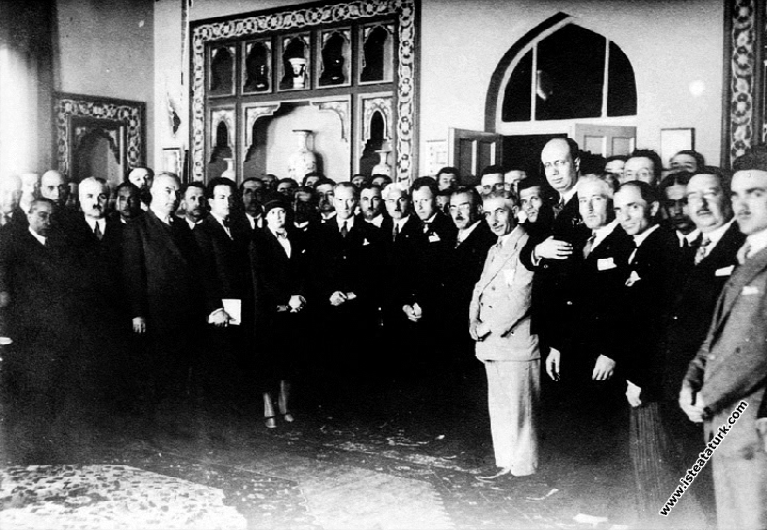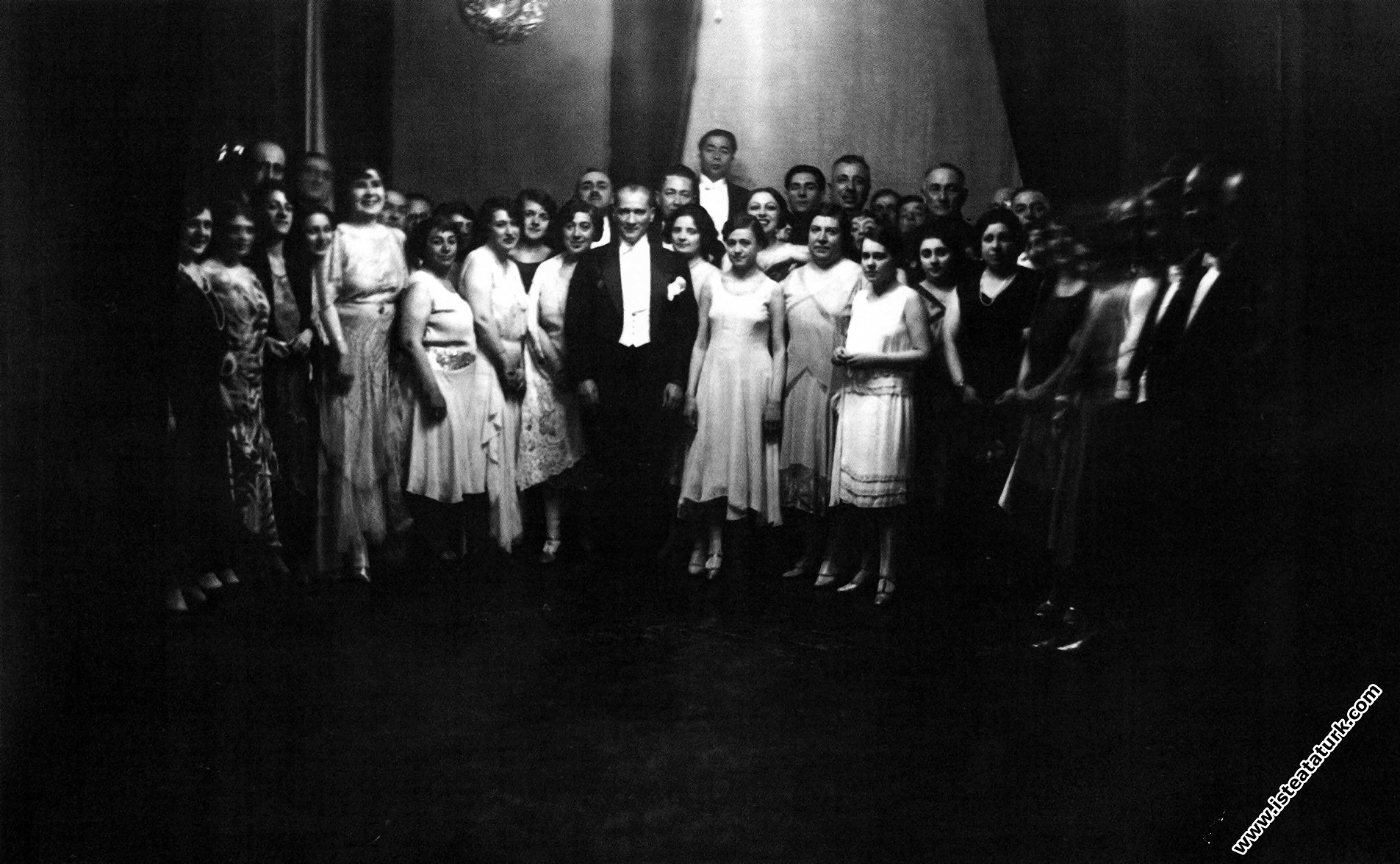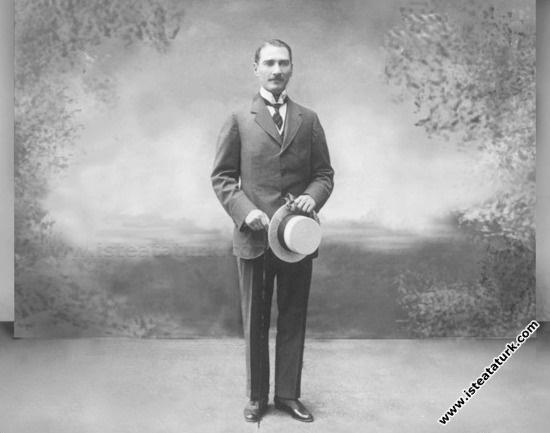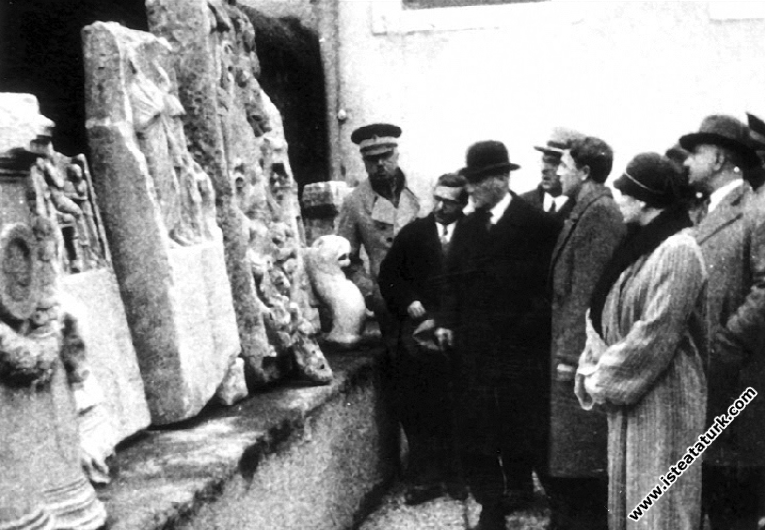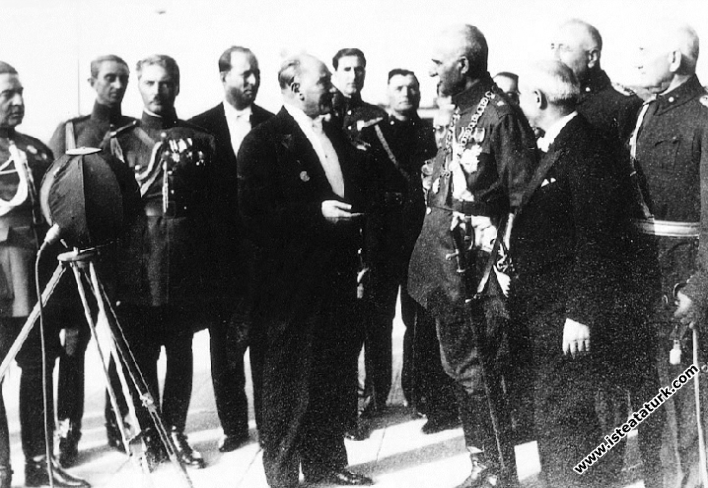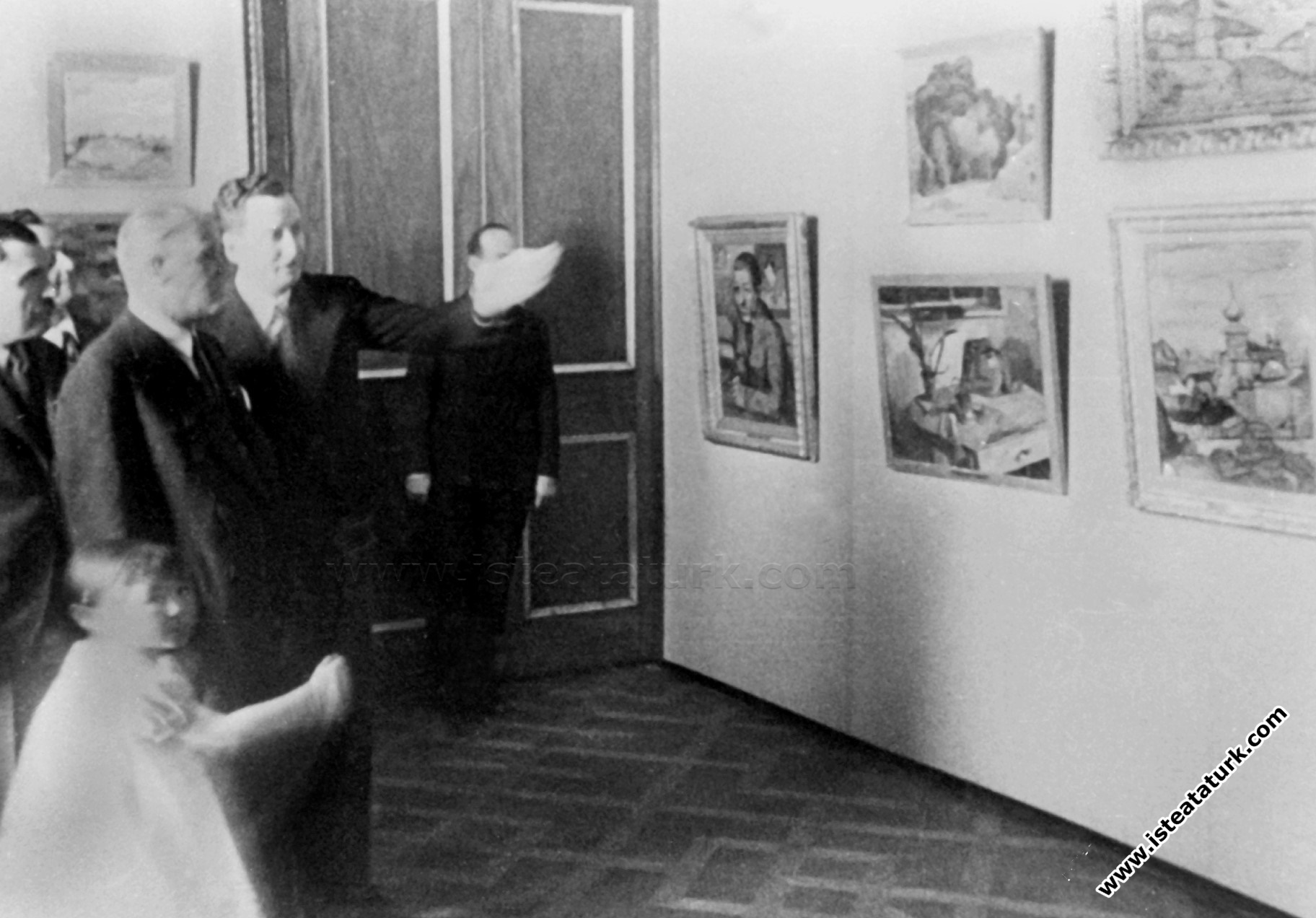
The Effects of Atatürk's Artist Personality on Art and Artist
Character Size
"Sirs, you can all be MPs; you can be ministers; moreover, you can be President. But you cannot be an artist". Atatürk (April 11, 1930)
THE EFFECTS OF ATATÜRK'S ARTIST PERSONALITY ON ART AND ARTIST'S APPROACH
SUMMARY
Atatürk's artistic personality and how this personality might have given meaning to the concepts of art and artist can only be explained by his discourse and actions, since he does not have his own definitions. While making these definitions, it is aimed to reveal his approaches to art and artists by interpreting his thoughts and behaviors, and to reveal the meanings Atatürk attributed to these concepts.
Establishing a state and equipping it with brand new institutions is a delicate and difficult task. Reshaping the society he leads by working like a paste is probably no less valuable than the patience and effort of a sculptor. Atatürk spent his heart, which the sculptor poured into stone and wood, for his country and society. His passion and effort to create a capital of millions from a steppe center of twenty thousand people in Anatolia is as subtle as the lines and motifs that the painter transfers to his canvas, and the reflection of this intelligence. Just as the quality of art gains value according to the talents of the artist, the work of a leader gains meaning and content according to his abilities. Many people who took the lead in the world have not been able to produce a work of the same and perfection. The form and quality of the work, the talent, intuition of the person who created it,
Many words have been said about Atatürk, and many books have been written about him2. The characteristics that determine his personality and which are found in very few leaders are mentioned in these publications.
3 arts in one source;
a- All the methods used in the expression of an emotion, a design or beauty; the superior creativity achieved as a result of these methods.
b- All the rules applied to make something beautiful.
c- All the rules to be followed in a profession. (Military art)
d- Mastery and ability to do something.
In another source4 artists;
It is defined as a person who deals with one of the fine arts and is particularly successful in it.
Maybe, in the classical sense, Atatürk is a person who paints, plays music, plays theatre, etc. is not an artist. But if we consider art as the reflection of emotions in its most essential sense, it is necessary to accept the institutions created by the political thoughts of man as a work of art5.
Atatürk's writings, the support he gave to artists and art, the art schools he opened, as well as the fact that he shared the artists with these goals while reaching his goals is a part of his artistic personality. The first seeds of Atatürk's artistic personality were sown with poetry. The fact that Ömer Naci, one of the famous orators of the Constitutional Monarchy,6 was a good poet and a strong speaker, influenced him and introduced him to poetry. Meanwhile, in the Manastır Military High School, which he was studying, the difficult situation of the Ottoman Empire, the inadequacies of the administrators in the country, the attitudes of the imperialist states against the empire, the loss of land and the persecution of the Turks in these lands affected him deeply. However, thanks to the foresight and sensitivity that can be found in artists, he started to oppose with the poem "HAKİKAT" 7.
Truth
Unwary! Which three centuries, which ten centuries?
Danube is a Turkish land from time immemorial
Known dates did not say this
The veils are rising, the veiled will be born!
Listen to the voice of the born history
Dark in the light, dawn in the dark
Bury the fake date and go to the right date.
Oghuz sons in the middle of Asia
Oghuz descendants in Europe's Alps
Us coming out of the east, us again in the west
Wherever we are, we know ourselves.
If only people knew themselves
It is known then that we always know.
Turk is not just the name of a nation
Turk is the union of all men
O heaps of people sharpening their teeth
Oh the bulk of human heedlessness
Let the curtain of heedlessness in the eyes be torn,
Where is the truth?
Artist; Although he aims to find the new, present the unavailable, and express his feelings, he accepts using his art as a tool and reacting to the situation he is in, as the natural outcome of his art. In this context, Atatürk has an artistic personality, even with his poem "Truth". This poem, which he wrote in 1897, may have made an important contribution to the establishment of the Turkish Historical Society and to the creation of the Turkish History Thesis8.
Speaking well and speaking well are among the arts. It is a fact that we all know that Atatürk carefully and sensitively chose even the orders he gave on the battlefields. Consider an order that says, “If you don't have ammo, you have bayonets! I don't want you to attack, I want you to die”9 to be concise. Let's look at the harshest words he said when he was at his most angry; “I'm amazed at your miserable mind, you idiot...10”. He said to the Anadolu Agency reporter on June 10, 1926, on the occasion of the Izmir assassination, and expressed his belief in the Republic, “My humble body will, of course, become soil one day. But the Republic of Turkey will stand firm forever.” The word has taken its place among the unforgettable aphorisms. Namık Kemal;
“The enemy has put his dagger in the heart of the homeland,
Is there anyone who will save his lucky black mine.”
Referring to his couplet, Atatürk talked about the First İnönü War in the Parliament;
“Let the enemy put his dagger in the bosom of the homeland,
It will be found, it will save its lucky land mine”
He responded to art with art1'.
It is known that Atatürk, who said that he loved poetry and literature, translated poems from French in particular, and wrote a "Merciye" (lament) describing the emotions caused by the death of a soldier during his presidency12.
The Nutuk13, in which he narrates all the developments and gives an account before history, is a work of art in itself. When the work is examined thoroughly, it will not go unnoticed that a scientific work is presented within an artistic aesthetic.
Regardless of the tool he uses, the artist is also a leader who activates the society. In this context, Atatürk has an artistic personality. His discourses, his effective presentation, and the care in choosing his words have always impressed those who are in front of them, and he has been able to activate them with his logical and fluent style. It is possible to support Atatürk's artistic personality with many things he did. However, since listing them one by one would require writing a whole book full of pages, it would be more correct to consider the artistic aspect as a part of his personality.
It is possible to see the passion for beauty in Atatürk's personality. The harmony in her dressing is a reflection of this. And she is so passionate about beauty as to say “I can't stand the ugly14”. “Art is the expression of beauty. If this expression is used with words, it is poetry, if it is with melody, it is music, if it is with painting, it is painting, if it is with carving, it is sculpture, if it is with building, it is architecture.
Atatürk accepted art as a complement to his revolutions and gave advice to artists on this subject. He also gave importance to institutionalization and teamwork, and directed musicians to team work by telling them to form groups16.
Art has such an abstract power that it is a value that connects people in the world and brings them together at common points. That's why, in his Tenth Anniversary Speech, Atatürk said, "I should also emphasize that the historical characteristic of the Turkish nation, which is a high human community, is to love fine arts and to rise in it. That is why it is our national ideal to develop our nation's high character, tireless industriousness, innate understanding, devotion to science, love for fine arts, and sense of national unity by constantly nurturing it with all kinds of tools and methods. This ideal, which is very suitable for the Turkish nation, will make it successful in doing its part in ensuring real peace in all humanity17”. In other words, “People need certain things to mature. A nation that cannot paint, a nation that cannot sculpt, a nation that cannot do what technique requires; it must be admitted that that nation has no place in the path of progress18”. In another, he brought fine arts to the fore by saying, "A nation without art means that one of its lifelines has been severed".
Today, nations have to overcome three important factors in order to raise themselves to the level of contemporary civilization and to prove this to other nations. The first is their economic structure, the second is the way their social order works, and the third and perhaps most important is their culture. Now we think of what this powerful factor, culture, is. The dictionary meaning is “all the social, religious and similar aspects of the civilization created by a society, based on the mind, artistic works19”. We can accept science and technology, which is a necessity of our age, as a cultural factor. However; Now it is in the interests of each nation to support each other scientifically and technologically. What is national, on the other hand, is the values that reflect his own way of life, that he brought beforehand and that he developed today and transferred to the future. Here are these values,
Atatürk's culture; “a) in the state life of a human society, b) in the life of thought, in short in science, sociology and fine arts; c) the resultant combination of what he can do in his economic life, in short, in agriculture, crafts, trade, land, sea and air transportation21” and accepted fine arts as an element in culture.
While taking the steps towards modernization, Atatürk always tried to adopt this duty with his rational approaches; “Success in fine arts is the surest proof of the success of all reforms. What a pity for the nations that failed in this. Despite all their achievements, they will always be deprived of being recognized for their high humanity in the field of civilization22” and expressed the necessity of being successful in fine arts.
On 11.4.1930, when he was with the artists at the Marmara Mansion in Ankara, due to the opening of the Turkish Hearth Theater: “Sirs; you can all be MPs; you can be a minister; What's more, you can be President. But you cannot be an artist23”, he briefly explained in my view of the artists.
Conclusion
It is very difficult to separate Atatürk's artistic personality from his other personalities, and it would be to underestimate his genius. The artist's personality, which we have examined in the sections so far, has been tried to be explained with his own discourses, actions and thoughts. The meanings attributed to the concepts of art and artist by Atatürk's artistic personality are;
There are obvious oppositions in the artist's inner structure. There is hardly a leader whose protests are as loud as Atatürk. In this context, Atatürk's art; “Injustices, wrongs, etc. a tool to oppose negativities”, also the artist; “A person who feels, thinks, judges and makes the right decision before any other person and expresses this with his art”.
-Art with the high horizon of emotion and thought created by Atatürk's artistic personality, "the whole of actions that give people a high horizon of emotion and thought", and the artist as "a person who has gained the ability of a high horizon of emotion and thought and can transfer it to those who do not have the same skills by adding it to his life" .
-Atatürk felt the power of art in the field of civilization with the sensitivity that artists can have, and therefore, art is "a means of being on the side of civilized nations", and the artist is "the person who promotes the high human qualities that exist in himself and his nation through his art".
Knowing that not every person can be an artist, the art of Atatürk is "the field of work of talented people", and the artist is "a person who has the ability to do what others cannot do".
-The artist is fond of beauty. Ataturk's emphasis on beauty is obvious. With this feature, art can be described as "the whole of the rules consisting of the combination of aesthetics and beauty", and the artist as "the person who presents aesthetics and beauty to other people with expressive24 approaches".
1 COŞKUN, Saffet, “Atatürk and Art”, DGSG Müd. Conferences 2, Şanlı Urfa, 1990, p.3.
2 ÜSTÜN, Emin Faik, Atatürk (Ideology), Ege University. Republic's 50th Anniversary Publication No:2, p,10. Based on M.Gökhan's Bibliography of Atatürk and the History of Revolutions (MEB Pub. Atatürk Series No.2, İstanbul, 1963), books, brochures, etc., published in the world about Atatürk and his Revolutions, were published until 1963. While stating that the number of students exceeded 2500, Atatürk's Principles and History of Revolution II YÖK. Arrow. In No.5, Ankara, 1986, p.9, there are nearly 1700 publications on Atatürk's personality and various aspects until 1981.
3 Meydan Larousse, Sabah Publishing, Volume 17, Istanbul, p.269.
4 DEMIRAY, Kemal. Basic Turkish Dictionary, Revolution and Aka Publishing House, Istanbul, 1982, p.806.
5 AKGÜN, Seçil, “Atatürk's Understanding of Art and Culture”, 100th Anniversary Atatürk Conferences, Petrol Ofisi AO General Manager, Ankara, 1981, p.8.
6 Ömer Naci (1880-1916): One of the famous orators of the Constitutional Monarchy. He joined the fighters against Abdülhamid and fled to Paris. He died at a young age on the Eastern Front in World War I. See. Baha Toros: Turkish Orators, p.33.
7 STRONG. Yılmaz, “Similarity Between Atatürk and Gökalp's Poems”, Milli Kültür, Vol.3. No.7, 1981. p.18.
8 Atatürk, first of all, to the Turkish Grand National Assembly. In his opening speech of 1928 (November), “To establish Turkish History on the right foundations; He put forward the thesis, which can be summarized as "to make the Turkish language broad with its value". Right after, this thesis was popularized with the books named History Notes for high schools in 1929 and Turkish History Main Hatları (Devlet Printing House 1930, MEB. Publications 1931) in 1930-1931. The thesis, which sheds light on some western scientists, has shaken the judgments of historians who started European culture with the Greeks. (See Abel Rey: Science Before the Greeks in the Evolution de I'Humanite series.). PERIN, Cevdet, Atatürk Cultural Revolution, Revolution and Aka Bookstores, Istanbul, 1982. pp.61-62.
9 Atatürk ordered this. During the Dardanelles wars, when the British landed in Seddülbahire, when they attacked without waiting for orders and stopped the enemy, some of the soldiers said, "We have no ammunition," and resisted their desire to withdraw. See. BALABANLAR Master, KANDIR Şebnem, SÖĞÜT Mine, ERDİNÇ Cengiz. BALIKCIOGLU Tugba. 75 Years of Turkey, Tempo Magazine, Hürgüç Gazetecilik A.Ş., Istanbul, 1998. p.76. However. Ataturk's Sayings and Writs I, TTK, translated into Turkish by Sunullah ARISOY. Yay., Ankara, 1982, p.21, there is no "I want you to die, not an attack" part.
10 BALABAN, KANDIR, SÖĞÜT, ERDİNÇ. BALIKÇIOĞLU p.79.
11 For more information, see Atatürk and His Revolution History Bibliography Ministry of National Education Publications.
12 A. Mumcu et al. Ataturk's Principles and History of Revolution II, YÖK. Arrow. No.5. Ankara, 1986, p.200. Poems and Elegy are not included in the source.
13 ATATÜRK, Mustafa Kemal, Speech, Türk Ocakları Delegation Merkeziye Printing House, Ankara, 1927. (First edition)
14 TURANI. Adnan, Atatürk and Fine Arts, Atatürk and Culture, H.U. Arrow. Special Issue, Ankara, 1982, p.104.
15 Kemalism I, Istanbul, 1984, p.371.
16 AŞKUN, İnal Cem, Conversations on Atatürk, Anadolu University. Eskisehir, 1999.
17 Atatürk's Speeches and Statements II, Ministry of National Education, 1952, pp.271-272.
18 Kemalism I, p.367.
19 DEMIRAY. p.610.
20 GÜMÜŞTEKİN, Ahmet, “Cultural function and Music” GOP. unv. FEAS., Business Club Journal No.3, Tokat. January 2000, p.12.
21 İNAN, Afet, What I Wrote from M. Kemal Atatürk, 1971, p.43.
22 Kemalism I. p.365.
23 ÖZERDİM, N. Sami, Atatürk's Handbook. Turkish Language Institution Publications, No.483, 1981, p.161. Kemal ARIBURNU: Memories from Atatürk, Türkiye İş Bankası Publications, Ankara 2nd Edition, 1976 p.225. From Muhsin Ertuğrul's article on the 14.4.1963 issue of Cumhuriyet newspaper. In addition to the sentence here, there is also the sentence "Let's love these children who dedicate their lives to a great art...".
24 (Edb) Contemporary art movement that is opposed to naturalism and impressionism and expresses the contents of spiritual life and spiritual contents. (Synonym. Expressionism). See, DEMİRAY. p.247.
Utilized resources:
AKGÜN, Seçil: “Atatürk's Understanding of Art and Culture”, 100th Year Atatürk Conferences, Petrol Ofisi AO General Manager, Ankara, 1981.
ARIBURNU, Kemal: Memories from Atatürk, Türkiye İş Bankası Published, 2nd Edition, Ankara, 1976.
ARISOY, Sunullah: What Atatürk Said and Wrote I, TTK. Pub., Ankara, 1982
AŞKUN, İnal Cem: “From the Talks on Atatürk”, Anadolu University, Eskişehir, 1999.
ATATÜRK, Mustafa Kemal: Speech, Turkish Hearths Delegation Center Printing House, Ankara, 1927.
Speeches and Statements, II, MEB Pub. 1952.
BALABANLAR Mürşit: “75 Years of Turkey”, Tempo Magazine, Hürgüç KANDIR Şebnem, Gazetecilik A.Ş., İstanbul, 1998.
SÖGÜT Mine, ERDİNÇ Cengiz, BALIKÇIOĞLU Tuğba, COŞKUN Saffet: “Atatürk and Art”, DGSG Müd. Conferences 2, Şanlı Urfa, 1990.
DEMİRAY, Kemal: Basic Turkish Dictionary, İnkılap and Aka Publishing Houses, Istanbul, 1982.
GÜMÜŞTEKİN, Ahmet: “Cultural function and Music” GOP Unv. FEAS., Business Club Journal No.3, Tokat, January 2000.
GÜRBÜZ, Yılmaz: “Similarity Between Atatürk and Gökalp's Poems”, Milli Kültür, Vol: 3, Issue. 7, 1981.
İNAN, Disaster: What I Wrote by M. Kemal Atatürk, 1971
ÖZERDİM, N.Sami: “The Atatürk's Handbook”, Turkish Language Institution Publications, No. .483.1981
PERIN, Cevdet: Atatürk Cultural Revolution, Revolution and Aka Bookstores, Istanbul, 1982.
TURANI, Adnan: “Atatürk and Fine Arts”, Atatürk and Culture, H.U. Arrow. Special Issue, Ankara, 1982.
ÜSTÜN, Emin Faik: Atatürk (Ideology), Ege University. Republic's 50th Anniversary Publication No:2. 1973.
MUMCU, A, ÖZBUDUN, E., FEYZİOĞLU, T., USKEN, Y., ÇUBUKÇU, A.: Atatürk's Principles and History of Revolution II, YÖK. Arrow. No.5, Ankara, 1986.
GÖKHAN, M.: Bibliography of Atatürk and His Revolutions History, Ministry of National Education Publications
Lecturer Ahmet Gümüştekin *
* Gaziosmanpaşa University Music Department
Source: ATATÜRK ARAŞTIRMA MERKEZİ DERGİSİ, Sayı 51, Cilt: XVII, Kasım 2001
